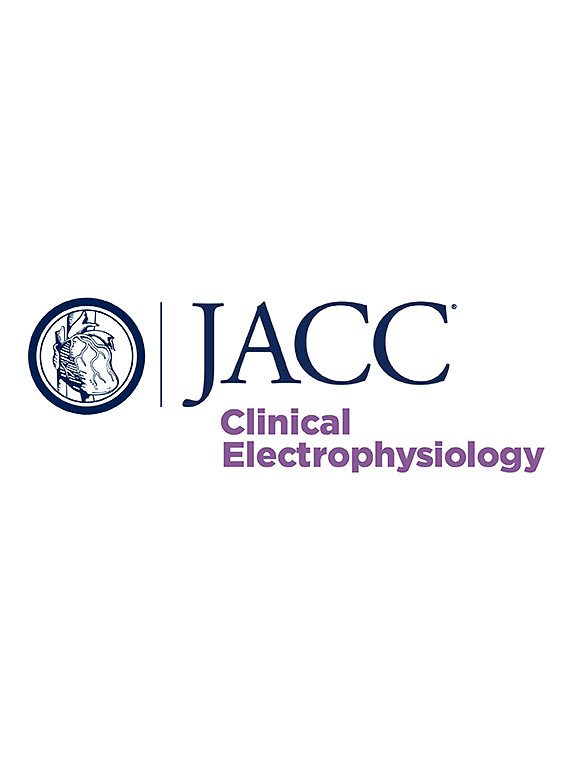利用超短期心率波动预测心脏性猝死
IF 8
1区 医学
Q1 CARDIAC & CARDIOVASCULAR SYSTEMS
引用次数: 0
摘要
背景:传统的心率变异性(HRV)测量与心脏性猝死(SCD)的关系不大。与传统的心率变异工具相比,去趋势波动分析(DFA)在评估短期缩放指数的方法上有了新的发展,可能是一种更优越的方法:在这项研究中,作者研究了 DFA 与 SCD 之间的关联分析:研究人员在前瞻性 FINCAVAS(芬兰心血管研究)中对 2794 名接受临床运动测试的参与者进行了研究,研究了超短期心率波动(1 分钟心电图样本)与 DFA 在静息和不同体力消耗阶段对 SCD 事件的预测价值。新的关键DFA测量指标--用二阶去趋势计算的短尺度缩放指数(DFA2 α1)是主要的暴露变量。SCD按照美国心脏协会/欧洲心脏病学会的标准进行定义,使用附有事件书面记录的死亡证明:在中位随访 8.3 年(Q1-Q3:6.4-10.5)期间,共发生 83 例 SCD。静息时(而非运动时)测量的 DFA2 α1 与 SCD 风险有非常显著的相关性,低 1-SD 的值与 2.4 倍(Q1-Q3:2.0-3.0)的风险相关(P < 0.001)。在调整了 SCD 的其他主要风险因素(包括年龄、心血管疾病、心肺功能、心率降低和左心室射血分数)后,上述结果依然存在。常规心率变异参数(在运动的任何阶段或静息时测量)与SCD之间的关系要弱得多,而且在调整其他风险因素后,两者之间的关系在统计学上并不显著:结论:在静息状态下测量的超短期 DFA2 α1,是预测 SCD 的强有力的独立指标。DFA2 α1与SCD之间的关系会因体力消耗而改变。本文章由计算机程序翻译,如有差异,请以英文原文为准。
Prediction of Sudden Cardiac Death With Ultra-Short-Term Heart Rate Fluctuations
Background
Conventional measures of heart rate variability (HRV) have shown only modest associations with sudden cardiac death (SCD). Detrended fluctuation analysis (DFA), with novel methodological developments to evaluate the short-term scaling exponent, is a potentially superior method compared to conventional HRV tools.
Objectives
In this study, the authors studied the analysis of the association between DFA and SCD.
Methods
The investigators studied the predictive value of ultra-short-term heart rate fluctuations (1-minute electrocardiogram samples) with DFA at rest and during different stages of physical exertion for incident SCD among 2,794 participants undergoing clinical exercise testing in the prospective FINCAVAS (Finnish Cardiovascular Study). The novel key DFA measure, the short-scale scaling exponent computed with second-order detrending (DFA2 α1), was the main exposure variable. SCDs were defined by American Heart Association/European Society of Cardiology criteria using death certificates with written accounts of the events.
Results
During a median follow-up of 8.3 years (Q1-Q3: 6.4-10.5), 83 SCDs occurred. DFA2 α1 measured at rest (but not in exercise) associated highly significantly with the risk of SCD, with 1-SD lower values associating with a 2.4-fold (Q1-Q3: 2.0-3.0) risk (P < 0.001). The results persisted when adjusting for other major risk factors for SCD, including age, cardiovascular morbidities, cardiorespiratory fitness, heart rate reduction, and left ventricular ejection fraction. Associations between conventional HRV parameters (measured at any stage of exercise or at rest) and SCD were substantially weaker and statistically nonsignificant after adjusting for other risk factors.
Conclusions
Ultra-short-term DFA2 α1, when measured at rest, is a powerful and independent predictor of SCD. The association between DFA2 α1 and SCD is modified by physical exertion.
求助全文
通过发布文献求助,成功后即可免费获取论文全文。
去求助
来源期刊

JACC. Clinical electrophysiology
CARDIAC & CARDIOVASCULAR SYSTEMS-
CiteScore
10.30
自引率
5.70%
发文量
250
期刊介绍:
JACC: Clinical Electrophysiology is one of a family of specialist journals launched by the renowned Journal of the American College of Cardiology (JACC). It encompasses all aspects of the epidemiology, pathogenesis, diagnosis and treatment of cardiac arrhythmias. Submissions of original research and state-of-the-art reviews from cardiology, cardiovascular surgery, neurology, outcomes research, and related fields are encouraged. Experimental and preclinical work that directly relates to diagnostic or therapeutic interventions are also encouraged. In general, case reports will not be considered for publication.
 求助内容:
求助内容: 应助结果提醒方式:
应助结果提醒方式:


